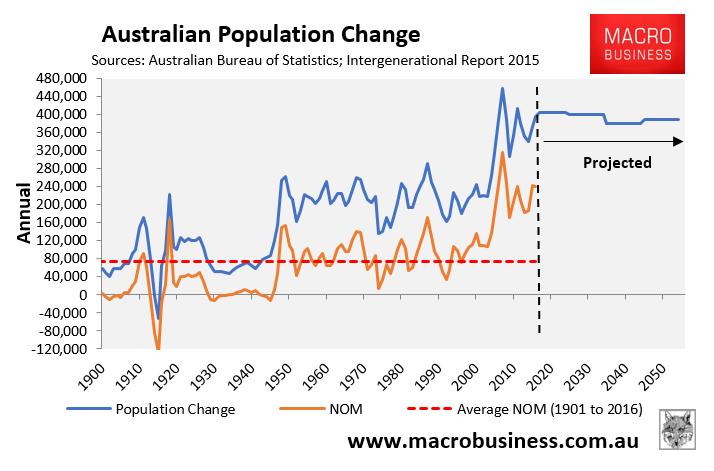
Any hope that Australia’s major political parties would support a more sustainable immigration have been hosed over the past 24 hours. Hot on the heels of Prime Minister Scott Morrison launching his decentralisation smokescreen, Labor leader Bill Shorten has backed the current intake on ABC Radio and deployed his own infrastructure smokescreen:
FAINE: And congestion is directly tied to immigration which was one of the drivers for the Liberal Party’s unrest last week.
SHORTEN: Well first of all, I understand the frustration of Australians about crowded infrastructure, and our immigration should be what’s in the national interest but part of that debate has to be fixing up our infrastructure.
But going back to where we started with the proposal from Victorian Labor about a railway…
FAINE: But this is about people’s concerns as cities become increasingly congested, people’s response is not to blame politicians for the failure to deal with infrastructure but instead to turn around and say let’s cut immigration. Does Bill Shorten want to cut immigration?
SHORTEN: Listen, our immigration is one issue but let’s talk about the failure of politics. The reason why I went back in detail to the history of an outer ring railway in Melbourne…
FAINE: So on immigration, simple yes or no answer, do you want to change the way we do immigration? Do you want to reduce the number of people who get permission to move to Australia?
SHORTEN: It’s not a simple yes or no issue. If we can take people in based upon our infrastructure, based upon the moving to the regions that’s a plus.
FAINE: So you agree with Alan Tudge, the newly sworn-in Minister, who says let’s try and get migrants to go to the regions rather than Sydney and Melbourne.
SHORTEN: Yeah I think that there is – and it’s not just the regions. You know, South Australia, there are plenty of places who would like to take some migrants. Immigration has been good for Australia but there’s no point in bringing in masses and masses of people if our infrastructure isn’t keeping pace. So I guess what I’m saying is you can’t just look at one part of it. We’re an immigrant nation and immigration has been good.
Jon your family, my family, pretty much anyone other than a first Australian came from somewhere else. But having said that we’ve got to make sure that we’re not you know just being ignorant of what happens if we’re overcrowding our cities so that’s why you’ve got to deal with the frustration people have on infrastructure.
Who is representing the Australian people? The past five opinion polls on the issue have clearly shown that Australian voters want immigration to be reduced:
- Australian Population Research Institute: 54% want lower immigration;
- Newspoll: 56% want lower immigration;
- Essential: 54% believe Australia’s population is growing too fast and 64% believe immigration is too high;
- Lowy: 54% of people think the total number of migrants coming to Australia each year is too high; and
- Newspoll: 74% of voters support the Turnbull government’s cut of more than 10% to the annual permanent migrant intake to 163,000 last financial year.
Labor’s inequality agenda would be greatly strengthened by also halving the permanent migrant intake – i.e. returning it back to something more in line with the historical average.
Income inequality and home ownership would be improved as there would be less upward pressure on house prices, particularly in Sydney and Melbourne, and less economic rents flowing to the owners of capital (who benefit the most from mass immigration while ordinary residents bear the costs).
Wages growth would also improve, other things equal, as there is less competition for jobs and workers’ bargaining power is increased, which would also help to reduce inequality.
There would be less youth unemployment, as employers are incentivised to hire and train young workers and graduates rather than taking the easy route of importing a migrant.
Australia’s economic growth and job creation would also become more broad-based and less concentrated in inner Sydney and Melbourne. Lower population growth would take pressure off interest rates and the currency. Thus, the Australian dollar would fall more quickly than otherwise helping to cushion the post mining-boom adjustment as tradable sectors become more competitive more quickly. This would spread benefits much more widely than just the “citizenship export” sectors of education, as well as simply piling more unproductive consumers into Sydney and Melbourne (blowing the current account deficit and increasing debt).
Lower population growth would also lift productivity and income by decongesting cities and, over the long-run, shares the depleting Australia’s fixed national endowment of resources among fewer people, also ensuring higher income per capita.
Labor needs to ask itself: how is maintaining a mass immigration program – which is projected to flood Sydney and Melbourne with 87,000 and 97,000 people a year respectively for decades to come – compatible with a fairer, more sustainable and socially cohesive Australia?
Such turbo-charged immigration necessarily will make housing affordability worse, dilute workers’ bargaining power, enrich the capital owners and wreck overall livability (e.g. via worsening congestion).

